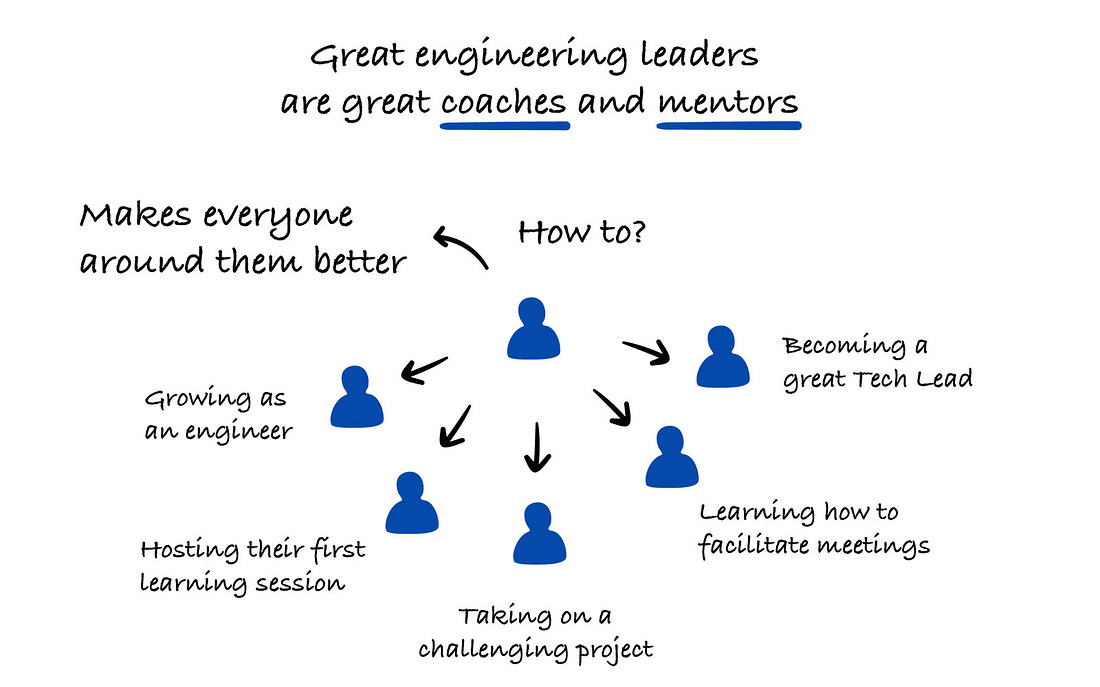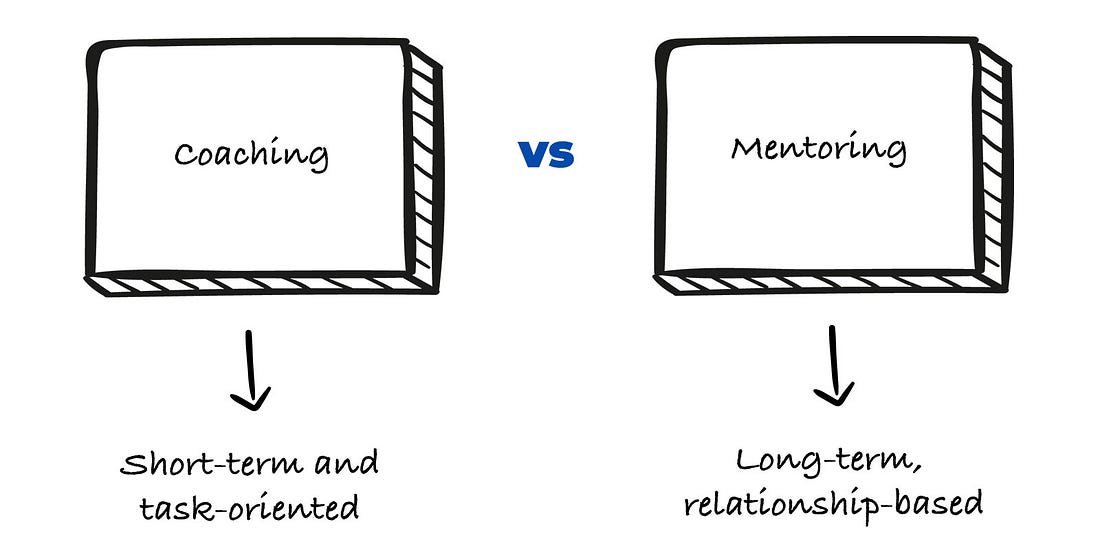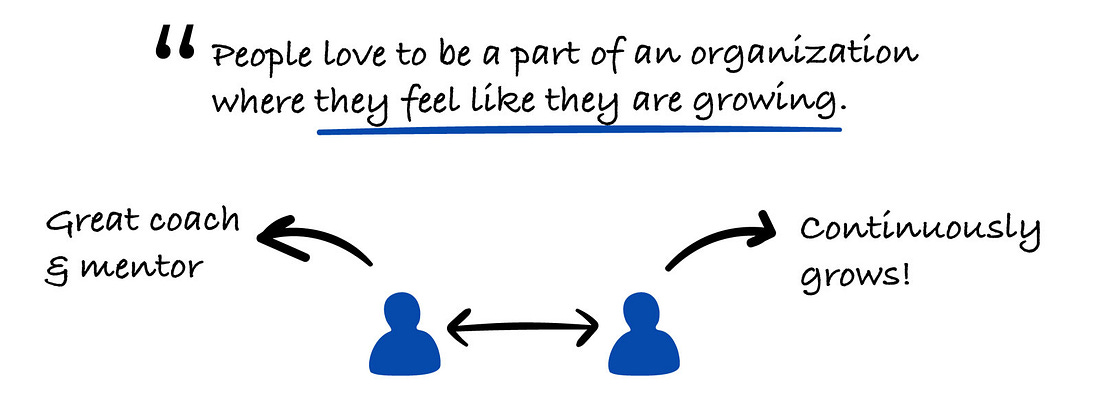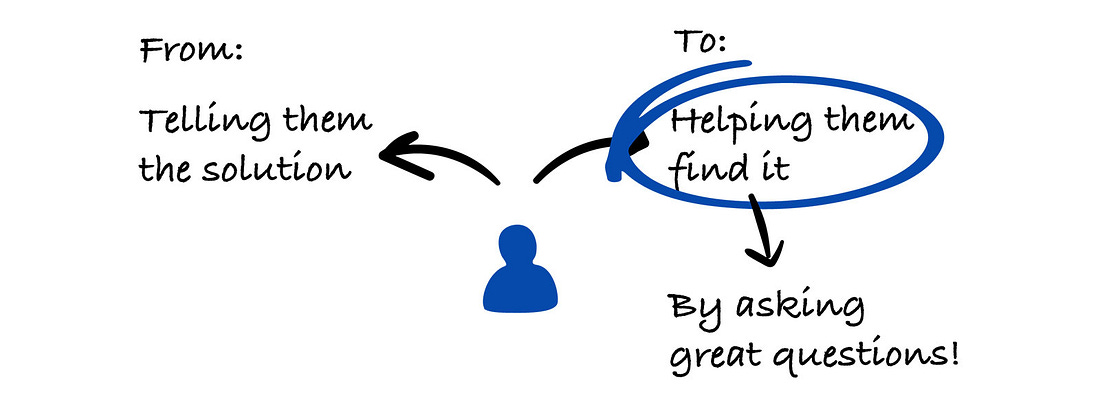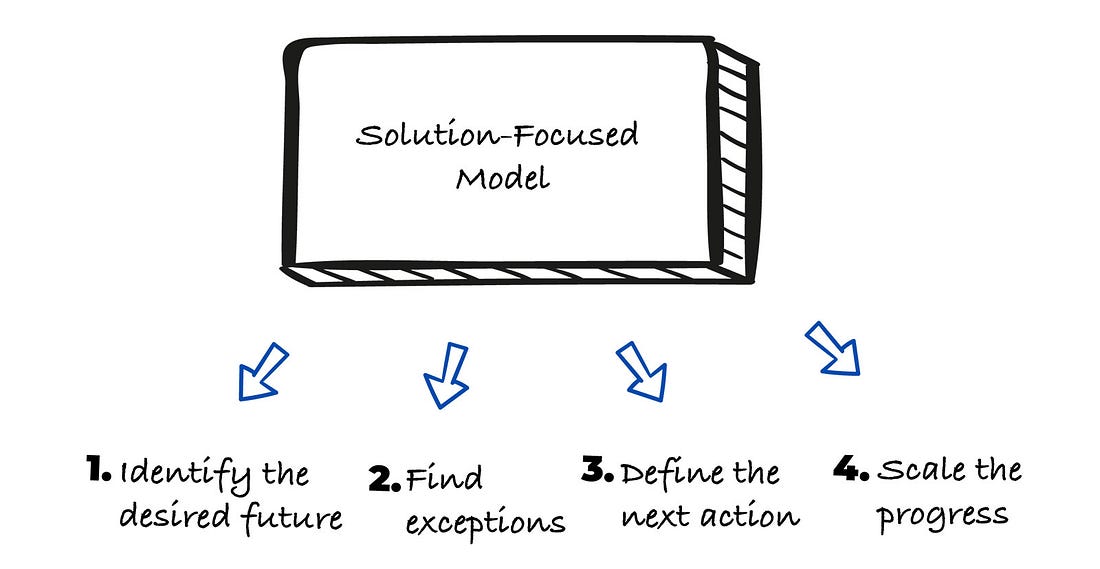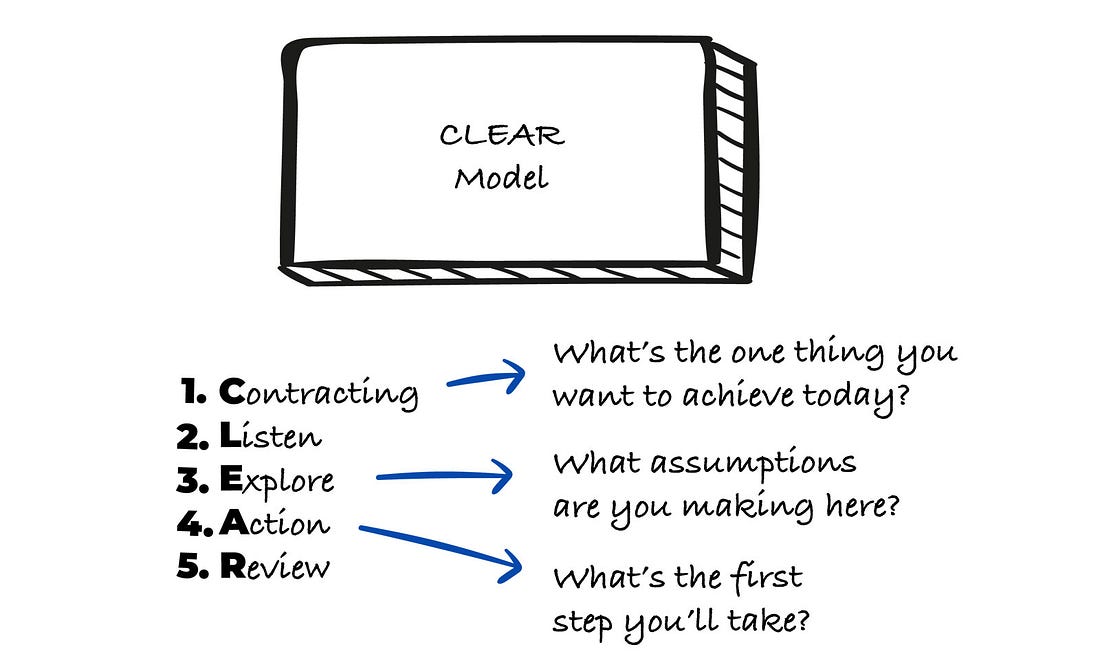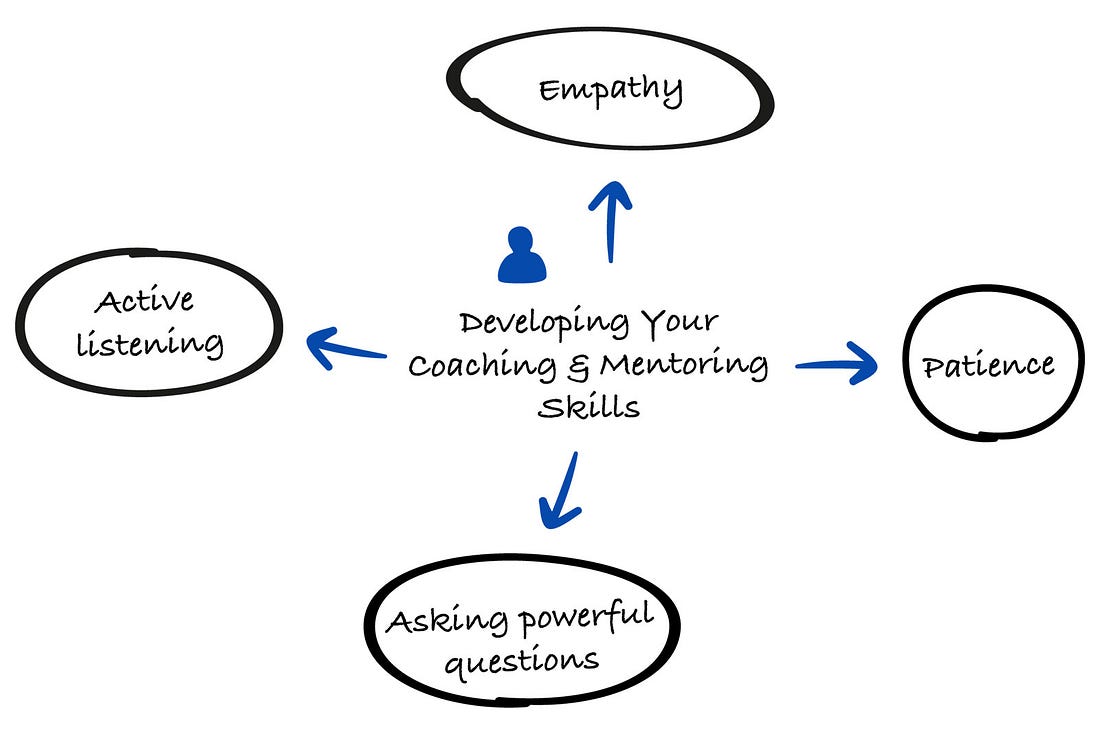Engineering Leader’s Guide: How to Become a Great Coach and Mentor
- Gregor Ojstersek and Andy Skipper from Engineering Leadership <gregorojstersek@substack.com>
- Hidden Recipient <hidden@emailshot.io>
Hey, Gregor here 👋 This is a free edition of the Engineering Leadership newsletter. Every week, I share 2 articles → Wednesday’s paid edition and Sunday’s free edition, with a goal to make you a great engineering leader! Consider upgrading your account for the full experience here. Engineering Leader’s Guide: How to Become a Great Coach and MentorBeing a great coach and mentor is crucial. Learn how to become one the RIGHT way!IntroOne of the most important things a great engineering leader does is to create leaders. And in order to do that, you need to become a great coach and mentor → to elevate everyone around you and help them grow. You’ve probably had one or more managers in the past, who you don’t consider to be great managers → and the exact reason for that is that they weren’t leaders. They weren’t making everyone around them better through coaching and mentoring. In order to have a great career as an engineering leader, it’s really important that you know and understand how to do coaching and mentoring the RIGHT way. To help us with this, I am happy to bring in Andy Skipper as a guest author, who has been primarily focusing on coaching and mentoring for the past 9 years! Let’s introduce our guest author for today’s article and get started. Introducing Andy SkipperAndy Skipper is the Founder and Chief Coach at CTO Craft, a community supporting thousands of CTOs and senior engineering leaders to thrive in their roles. With over 20 years of experience leading technology at Made.com, Comic Relief, and startups, Andy now focuses on coaching and mentoring engineering leaders → helping them navigate the pressures, elevate their impact, and build stronger teams. Today, he is kindly sharing his insights on what it takes to be a great coach and mentor as an engineering leader with us. Let’s get straight into it! 1. The Evolution of Engineering LeadershipRemember the days when the path to becoming an engineering leader was simply a matter of being the best coder on the team? We’d solve the most complex bugs, architect the most elegant systems, and our promotions felt like a natural extension of our technical prowess. You were the hero who swooped in to save a failing sprint, the one everyone turned to when the documentation just didn’t make sense. And honestly, it felt great, didn’t it? Our value was tangible, measured in lines of code and solved tickets. But somewhere along the way, the job changed. The title shifted from “Senior Engineer” to “Engineering Leader,” and suddenly, the metrics that defined our success became less about what we did ourselves and more about what our teams accomplished. It’s a tricky transition, one that often feels like trading a well-worn toolbox for a blank whiteboard. We were promoted for our technical skills, but the job now requires a completely different set of muscles:
I Tried to Do Everything Myself as a First-Time Engineering LeaderI was gifted my first proper leadership role in a very early-stage startup where I’d earned the trust of the other developers to write solid code, but also of the founders for my ability to translate their needs into priorities for the developers. In my ignorance, I took that as an expectation that I could only be trusted if I personally owned the hardest parts of building the product, alongside keeping the project on track.
I’d swapped their trust in me for distrust in them. A lesson that has never left me. This is the fundamental shift we have to make. We’re no longer the star player; we’re the coach. Our primary job is no longer to be the smartest person in the room but to create an environment where everyone else can be their smartest. It’s about moving away from “I’ll do it myself” to “How can I help you do this?” This is where the true art of leadership begins. It’s the journey from being a technical expert to becoming a strategic leader who builds not just products, but people. Coaching versus MentoringBefore we dive deep into today’s topic, it’s vital to understand the crucial difference between coaching and mentoring, two terms that are often mistakenly used interchangeably. Think of it this way:
It’s about helping someone solve a specific problem or acquire a particular skill by asking powerful questions and guiding them to their own answers.
It’s about sharing your own experiences, offering career advice, and providing a model for professional growth.
2. Why Coaching and Mentoring Are Non-NegotiableSo, we’ve established the shift from hero-engineer to strategic leader. Now, let’s talk about the “why.” Why should you, an already busy engineering leader, invest so much time and energy into coaching and mentoring? Isn’t it enough to just manage projects and hit deadlines? The short answer is no, and here’s why. Right now, we’re in a period of unprecedented employee turnover. Studies from major consulting firms show that nearly 40% of employees are looking to change roles. That’s a staggering number, and the reasons for their departure are directly tied to leadership. Among the top reasons cited are:
These findings aren’t just statistics; they are a direct challenge to the way we lead. They indicate that engineering leaders need to develop stronger coaching skills and become more intuitive when it comes to employee motivation and energy levels.
By actively coaching and mentoring your team, you’re directly addressing these issues. You’re not just a manager; you’re a career partner. You help them navigate challenges, build new skills, and find their place within the company’s vision. When a team member feels seen, supported, and challenged in a positive way, they’re less likely to look for opportunities elsewhere. Your investment in them becomes their reason to stay. Ultimately, your most profound impact isn’t the code you write or the features you ship. It’s the people you help develop. The engineers you mentor today are the tech leads, managers, and directors of tomorrow. By investing in them, you’re not just doing your job; you’re building a legacy that will outlast any specific project or product launch. Coaching and mentoring are not just “nice-to-haves”; they’re the cornerstone of effective leadership and the key to building a high-performing, sustainable, and truly successful team. 3. The Mindset ShiftWe’ve established the “why” → the immense value of coaching and mentoring for your team, your company, and your legacy. Now for the “how” → it all starts with a fundamental mindset shift. This is the hardest part, the true challenge of moving from a technical expert to a leader of people. It’s the shift from being a “teller“ to being a “coach.” The “telling” mindset is familiar and comfortable for most of us. A team member comes to you with a problem, and you give them the solution. They ask how to approach a task, and you provide a step-by-step guide. We do this because it’s efficient, and we often genuinely believe we’re being helpful. After all, you have the experience, the answers, and the shortcuts. You can solve it faster than anyone else. But what does this really teach your team? It teaches them to be dependent on you. It tells them that their job is to execute your instructions, not to think critically or solve problems for themselves.
Instead of giving the answer, you guide the person to find it themselves. When a team member comes to you with a problem, your first instinct should no longer be to offer a solution. Instead, ask questions like:
This Approach Can Feel Slow at FirstIt takes more time and patience than just blurting out the solution. But the long-term payoff is monumental. When you ask powerful questions, you’re not just helping them solve the immediate problem; you’re teaching them a repeatable problem-solving process. You’re building their confidence, their critical thinking skills, and their ability to become an independent and resourceful member of the team. This is the difference between giving a person a fish and teaching them how to fish. This mindset shift is about letting go of the need to be the hero. It’s about empowering your team and believing in their ability to grow.
Embracing this coaching mindset is the single most important step you can take on the journey to becoming a truly great leader. 4. Practical Frameworks for 1:1sThe mindset shift from “telling” to “coaching” finds its most practical application in your one-on-one meetings. These aren’t status updates; they are the dedicated time you have to coach, mentor, and build a relationship with your team members. Without a plan, they can easily become unstructured and unproductive. This is where frameworks come in. They provide a simple, actionable structure to ensure your 1:1s are impactful and effective. While there are many excellent coaching models out there, two of the most powerful and practical that I come back to most often are:
Let’s explore how you can use each one to supercharge your 1:1s. The Solution-Focused ModelThis model is your go-to for situations where you want to move quickly and pragmatically from a problem to a solution. It’s a forward-looking approach that empowers your team members by focusing on their strengths and what’s possible, rather than dwelling on what’s wrong.
Instead of asking about the problem, ask about the solution. Shift the conversation immediately by asking, “What does success look like in this situation?” or “If this problem were solved tomorrow, what would be different?”
Help your team member recall a time when the problem was less severe or didn’t exist. This shows them that they already have some of the skills or resources they need. Ask, “Tell me about a time you handled a similar situation well,” or “What was working the last time you were tackling something like this?”
Use a simple rating scale to make progress tangible. Ask, “On a scale of 1 to 10, with 1 being ‘the problem is at its worst’ and 10 being ‘completely solved,’ where are you now?” Once they give a number, ask, “What would it take to move from a 4 to a 5?”
Based on the conversation, help them identify one small, concrete step they can take immediately. Ask, “What’s one small thing you can do this week to move toward that 5?” The CLEAR ModelFor more in-depth developmental conversations, the CLEAR Model offers a comprehensive, agile-friendly approach. It’s especially useful for building trust and ensuring accountability over time.
Start by setting expectations for the conversation. “What’s the one thing you want to achieve today?” or “What would success look like for you by the end of this conversation?”
Before diving into solutions, dedicate time to truly listen. Allow them to fully articulate the problem, their feelings, and their thoughts without interruption.
This is where the magic happens. Use powerful, open-ended questions to help them explore the situation from different angles. “What assumptions are you making here?” “What other factors might be at play?” or “What’s an alternative way of looking at this?”
Once the team member has explored the issue, help them decide on a concrete plan. “What’s the first step you’ll take?” or “How will you know if your plan is working?”
This final step is often done at the beginning of the next 1:1. Check in on the actions they committed to and discuss what they learned. These frameworks transform your 1:1s from simple check-ins into powerful coaching sessions. By having a clear plan for your conversations, you’re not just managing a project; you’re developing a person. Handling Difficult Coaching ConversationsThe most challenging, yet crucial, part of a leader’s job is navigating difficult conversations. These moments are often uncomfortable but offer the greatest opportunity for growth. Mastering these situations requires courage and empathy to ensure the conversation remains constructive. When handled well, these moments can strengthen your team and your relationships. Here are key scenarios where your coaching skills will be put to the test: Coach the individual to understand the impact of their performance and collaboratively develop an improvement plan.
Your role isn’t to pick a side. Coach both parties to understand each other’s perspectives and find a mutually agreeable solution.
Practice delivering feedback in a way that is specific, actionable, and focused on behavior rather than personality.
This is perhaps the hardest conversation. Be compassionate and honest, helping the individual see that their skills may be better suited to a different role or company. 5. Developing Your Coaching & Mentoring SkillsSo, you’re bought into the mindset shift and you have a few frameworks in your back pocket. Now comes the work of actually developing these muscles. Becoming a great coach and mentor isn’t a one-and-done course; it’s a continuous practice. It requires a dedicated effort to cultivate a new set of skills that might feel unfamiliar at first. Essential Skills to Master
This goes beyond just hearing the words. It means listening to understand, not to reply. Pay attention to body language, tone, and what’s left unsaid. Put your phone away, close your laptop, and give the person your full, undivided attention. Try to see the world from your team member’s perspective. What are their motivations, fears, and frustrations? Empathy allows you to connect on a human level and tailor your coaching to their individual needs.
This is a big one. It can be incredibly tempting to jump in with the solution, especially when you know the answer. Resist that urge. Allow your team members the space to struggle, think, and find their own way. Your patience is a gift that builds their resilience and confidence.
We’ve touched on this, but it’s worth repeating. The quality of your coaching is directly related to the quality of your questions. Practice moving from “Why did you do that?” to “What was your thinking behind that decision?” or from “You should do X” to “What are some different ways you could approach this?” Recommended Resources & Where to StartBuilding these skills requires ongoing learning. Here are a few places to start:
The best way to learn how to coach is to be coached. Find a leader you admire and ask them to mentor you. Observe their style, and don’t be afraid to ask for direct feedback on your own leadership.
Don’t just wait for a major problem to arise. Use every 1:1 as a practice session. Pick one skill (like active listening) and focus on it for the entire conversation. Reflect afterward on what went well and what you could improve. It might feel a little clunky at first, but with consistent practice, these skills will become second nature. Becoming a great coach isn’t about having all the answers. It’s about empowering your team to find their own. Your journey to a coaching-first leader is a marathon, not a sprint. The most valuable investment you can make is in yourself, so you can then invest in your team. Conclusion: The Legacy of a Coaching-First Engineering LeaderAn engineering leader’s most enduring legacy isn’t the software they build or the deadlines they hit. These things are celebrated and then quickly become outdated.
Think about the mentors who shaped your career; their impact wasn’t a specific task they completed for you. It was a question they asked that helped you see a problem differently, or the confidence they gave you to take on a new challenge. By prioritising coaching, you are creating a ripple effect that will shape the professional lives of others long after your projects are complete. Your job isn’t to be the smartest person in the room; it’s to build a room full of brilliant people. The engineers you empower today will go on to lead their own teams, passing on the coaching mindset you taught them. This is an act of humility and generosity → you’re giving away your knowledge, time, and trust so that others can rise.
Last wordsSpecial thanks to Andy for sharing his insights on this very important topic! Make sure to check him out on LinkedIn and also check out CTO Craft → the community, events and mentoring circles → I’ve been a part of the community for 2+ years, and I definitely recommend checking it out. We are not over yet! Tech Lead is Becoming One of the Most Important Roles in Tech Because of AIThere was a lot of good feedback on Wednesday’s article and also from my talk at the Codemotion conference in Milan, Italy. In the latest video, I am sharing a bit more insights on the Tech Lead role becoming an increasingly important role in tech. 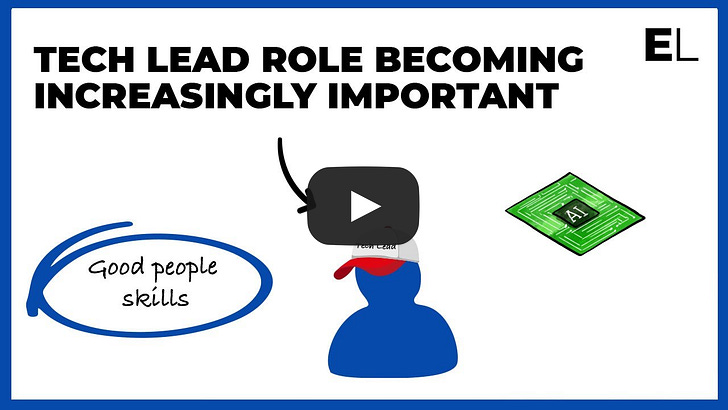 New video every Sunday. Subscribe to not miss it here: Liked this article? Make sure to 💙 click the like button. Feedback or addition? Make sure to 💬 comment. Know someone that would find this helpful? Make sure to 🔁 share this post. Whenever you are ready, here is how I can help you further
Get in touchYou can find me on LinkedIn, X, YouTube, Bluesky, Instagram or Threads. If you wish to make a request on particular topic you would like to read, you can send me an email to info@gregorojstersek.com. This newsletter is funded by paid subscriptions from readers like yourself. If you aren’t already, consider becoming a paid subscriber to receive the full experience! You are more than welcome to find whatever interests you here and try it out in your particular case. Let me know how it went! Topics are normally about all things engineering related, leadership, management, developing scalable products, building teams etc. Invite your friends and earn rewardsIf you enjoy Engineering Leadership, share it with your friends and earn rewards when they subscribe. |
Similar newsletters
There are other similar shared emails that you might be interested in:
